In an age saturated with digital images, the act of printing a photograph is a deliberate choice—a declaration that a particular moment is worthy of permanence. Yet, this permanence is fragile. The photograph, a tangible slice of memory, is vulnerable to the ravages of time, light, and accident. The choice of a frame, therefore, is not merely a decorative afterthought; it is the selection of a guardian for that cherished moment. For decades, glass has been the traditional choice, but its inherent fragility has always been its Achilles’ heel. A single fall can transform a protective barrier into a destructive force, shattering not just the glass but potentially the irreplaceable memory it was meant to shield.
Today, a modern material has emerged as the unequivocal standard for clarity, durability, and archival protection: the acrylic photo frame. Far from being a simple “plastic” substitute, acrylic is an advanced, optically brilliant polymer engineered for performance. It offers a combination of glass-like transparency and superior strength that traditional materials cannot match. This guide is designed to be the most comprehensive resource available on acrylic photo frames. It will take you on a journey from the fundamental science of the material itself—Poly(methyl methacrylate)—to a detailed, evidence-based comparison with glass. It will explore the vast taxonomy of frame styles available for every conceivable application, from a gallery wall to a car dashboard. Crucially, it will delve into the art of preservation, explaining the archival properties that make acrylic the choice of museums and galleries.
Finally, this guide will become intensely practical, providing step-by-step instructions for installation, cleaning, and maintenance. For readers in India, it offers a definitive local buyer’s guide, navigating the city’s retail, custom, and wholesale markets to help you find the perfect frame for your needs. This is your complete manual to understanding, choosing, and cherishing acrylic photo frames—the modern, superior way to give your memories the brilliant and lasting showcase they deserve.1
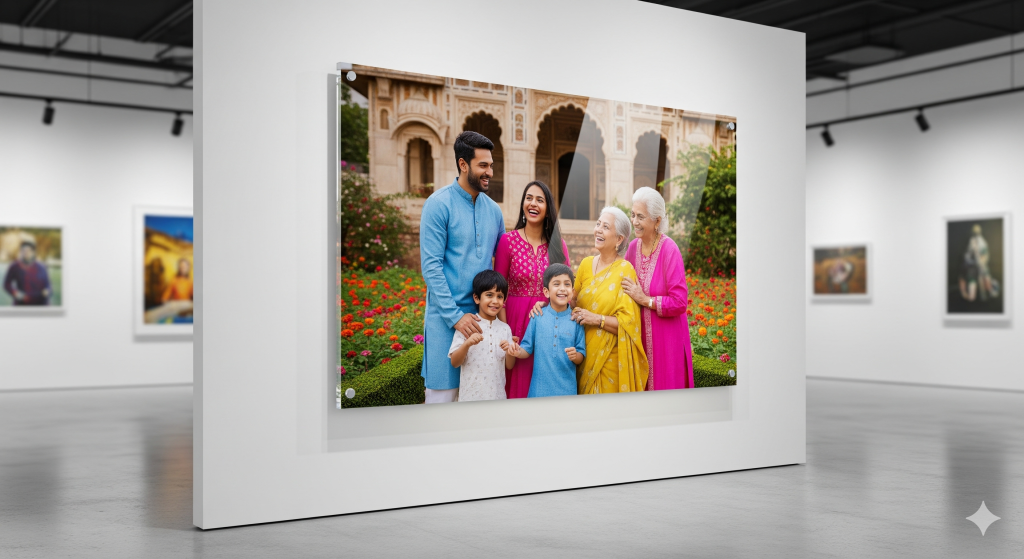
Part 1: The Science of Brilliance: What Exactly is an Acrylic Photo Frame?
To truly appreciate the value of an acrylic photo frame, one must first understand that “acrylic” is not a generic term for any clear plastic. It refers to a specific, high-performance material with a rich history in engineering, medicine, and design. Moving the perception of this material from “plastic” to “advanced polymer” is the first step in recognizing its superior qualities for protecting and displaying your most valued images.
Deconstructing “Acrylic”—The Power of PMMA
The material at the heart of every high-quality acrylic frame is a synthetic polymer known as Poly(methyl methacrylate), or PMMA.3 This transparent thermoplastic is an engineering-grade plastic derived from the monomer methyl methacrylate.3 Its chemical formula, represented as $(C_5O_2H_8)_n$, describes a structure of long, repeating molecular chains, which gives the material its unique combination of strength and clarity.3
PMMA is known by many trade names, which can often cause confusion in the marketplace. When you see products marketed under brand names like Plexiglas, Lucite, Perspex, Acrylite, or Crylux, you are looking at variations of Poly(methyl methacrylate).3 These are not different materials but rather different brands of the same fundamental polymer.
Its physical properties are what make it an exceptional alternative to glass for framing applications:
- Density and Weight: PMMA has a density of approximately 1.17–1.20 g/cm³. This is roughly half the density of typical glass, which ranges from 2.2 to 2.53 g/cm³.3 This significant difference is why an acrylic frame is dramatically lighter than a glass frame of the same size, a crucial factor for handling, shipping, and wall mounting.
- Optical Clarity: With a light transmission of up to 92% for a 3 mm thick sheet, PMMA is one of the clearest materials available, often surpassing the clarity of standard glass.3 Its refractive index of approximately 1.49 is very similar to that of crown glass, ensuring that images are viewed with minimal distortion.3 This high level of optical purity means that the true colors and details of your photograph shine through without the subtle green tint often present in standard glass.5
Because of these characteristics, PMMA is often referred to as an “organic glass”.3 It is a material that exists in a glass-like state at room temperature but is formed from organic molecules. This duality is its greatest strength: it provides the much-desired transparency of traditional glass while simultaneously offering the superior engineering properties of a modern polymer, such as impact resistance and light weight. It is not a lesser substitute for glass but a technological evolution that enhances both protection and presentation.
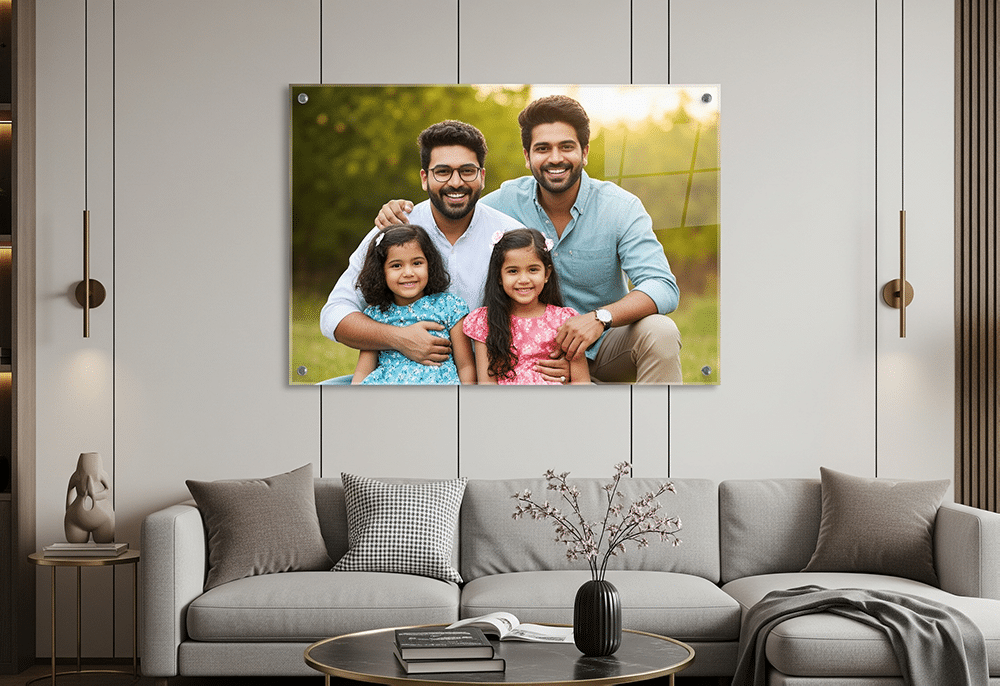
A Legacy of Strength: From WWII Cockpits to Modern Medicine
The trustworthiness of PMMA as a protective material is not a recent discovery. Its reputation was forged in some of the most demanding environments imaginable. During World War II, PMMA was the material of choice for the canopies and gun turrets of aircraft like the Boeing B-17 Flying Fortress.3 This application required a material that was not only optically clear for pilot visibility but also incredibly shatter-resistant to withstand the rigors of combat and high-altitude flight. Many of these decades-old canopies remain clear today, a powerful testament to the material’s long-term stability and inherent resistance to UV degradation.9
This legacy of durability extends to numerous other high-stakes applications. The spectator protection shields in ice hockey rinks, the viewing ports of deep-sea submersibles, and even the lenses in lighthouses are all made from PMMA.3 These uses underscore the material’s proven ability to perform under extreme pressure and impact.
Perhaps the most compelling evidence of PMMA’s safety and stability comes from the medical field. Due to its exceptional biocompatibility—its ability to exist in harmony with human tissue without causing an adverse reaction—PMMA is widely used in medicine.4 It is the primary component of “bone cement,” a substance used to anchor artificial joints and implants within the body. It is also used to craft dentures and dental fillings, where it can be easily colored to match natural teeth.4
The history of its use in ophthalmology is particularly remarkable. Sir Harold Ridley, an ophthalmologist working with Royal Air Force pilots, observed that when splinters of shattered PMMA from aircraft canopies became embedded in pilots’ eyes, they did not trigger the inflammatory rejection that glass splinters did. This discovery led to the development of the first intraocular lenses—artificial lenses implanted in the eye to treat cataracts—made from PMMA.4 A material trusted to be permanently implanted in the human eye or to protect a pilot in the sky has passed the most stringent tests of safety and durability. This history provides irrefutable proof that the same material used in a photo frame is more than capable of providing the ultimate protection for your priceless memories.

The Genesis of Clarity: How Acrylic Sheets are Made
Not all acrylic is created equal. The method used to manufacture the acrylic sheet is perhaps the single most significant factor determining its final quality, longevity, and price. This knowledge empowers consumers to look beyond the surface and ask the right questions when investing in a premium frame. The process begins with the raw material, a liquid monomer called methyl methacrylate (MMA), which is combined with catalysts and additives like UV stabilizers or impact modifiers.10 This mixture then undergoes a process called polymerization, where the individual MMA molecules link together to form the long, stable chains of solid PMMA.13
From this point, there are two primary methods used to form the PMMA into sheets: casting and extrusion. The choice between them creates two distinct grades of material with different properties and ideal applications.
1. Casting (Cell Casting): This is the premium, more labor-intensive method. The liquid PMMA mixture is poured between two sheets of high-grade glass, which act as a mold.11 The mold is then submerged in a temperature-controlled water bath or placed in an oven where the PMMA cures and polymerizes slowly.12 This gradual process results in a sheet with very little internal stress and a higher molecular weight.
The result is cast acrylic, which is renowned for its superior optical clarity, greater thermal stability, higher chemical resistance, and increased hardness, making it more scratch-resistant than its extruded counterpart.15 For any application where visual perfection and long-term archival quality are paramount—such as museum displays, high-end photography, and fine art framing—cast acrylic is the undisputed choice.10
2. Extrusion: This is a faster and more cost-effective manufacturing process. Solid PMMA pellets are fed into an extruder, where they are heated until molten. The molten acrylic is then forced through a die, which shapes it into a continuous sheet that is subsequently cooled by rollers.12 This method is highly efficient and produces sheets with a more uniform and consistent thickness (a tolerance of +/- 10% compared to +/- 15% for cast acrylic).18
However, the mechanical process of extrusion imparts internal stress into the material, resulting in extruded acrylic. This grade has a slightly lower optical quality, is softer and thus more prone to scratching, has a lower melting point, and is less resistant to certain chemicals.18 While it is an excellent material for general-purpose applications like signage or standard displays where cost is a primary driver, it is considered a step down from cast acrylic for high-quality picture framing.
The distinction is critical. A consumer paying a premium for a “gallery-quality” frame should be receiving a product made from cast acrylic. This knowledge allows buyers to ask suppliers a crucial question: “Is this frame made from cast or extruded acrylic?” The answer will reveal much about the product’s true quality and value.
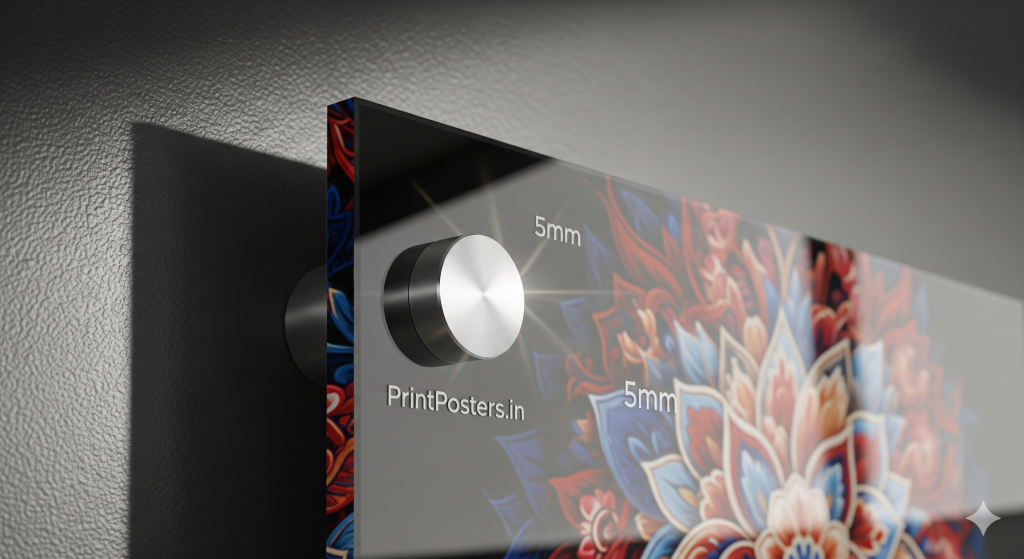
| Feature | Cast Acrylic | Extruded Acrylic | Why It Matters for Your Photo |
| Manufacturing Process | Liquid PMMA is poured into a glass mold and cured slowly. | Molten PMMA pellets are forced through a die to form a sheet. | The slower, more controlled casting process results in a higher molecular weight and less internal stress, leading to superior quality.[11, 14] |
| Optical Clarity | Exceptional. Higher light transmission and purity. | Very good, but slightly lower than cast. | Your photo’s colors will appear more vibrant and true-to-life behind the superior clarity of cast acrylic.[16, 17] |
| Scratch Resistance | More scratch-resistant due to a harder surface. | Less scratch-resistant and softer. | A cast acrylic frame will better resist minor abrasions from cleaning and handling over its lifetime.18 |
| Chemical Resistance | Higher resistance to solvents and chemicals. | Lower resistance. | Cast acrylic is less likely to be damaged by accidental exposure to household cleaners.18 |
| Thickness Tolerance | +/- 15% | +/- 10% | Extruded acrylic offers more precise thickness, but this is less critical for framing than optical quality.18 |
| Cost | More expensive. | More cost-effective. | The price difference reflects the significant gap in manufacturing complexity and final material quality.[17, 19] |
| Best For | Archival framing, museum displays, fine art, high-value photography. | General signage, budget-friendly displays, applications where cost is the primary factor. | For irreplaceable memories and professional displays, cast acrylic is the only appropriate choice for long-term preservation and presentation.[15, 19] |
Part 2: The Great Glazing Debate: Acrylic vs. Glass
For anyone looking to frame a photograph or piece of art, the central decision comes down to the glazing—the clear protective barrier that sits in front of the image. For centuries, glass was the only option. Today, acrylic presents a modern alternative that outperforms glass in nearly every meaningful category. This section provides a comprehensive, evidence-based analysis to settle the debate and guide you to the best choice for protecting your memories.
The Ultimate Showdown: A Feature-by-Feature Analysis
Making an informed decision requires a direct comparison of the materials across several key criteria, from safety and durability to visual appeal and long-term cost.
- Durability & Safety: This is where acrylic demonstrates its most decisive advantage. Acrylic is 10 to 20 times more resistant to impact than standard glass.6 In the vast majority of applications, it will not shatter. If subjected to extreme force, it tends to break into large, dull-edged pieces rather than the sharp, dangerous shards produced by broken glass.3 This shatterproof quality makes acrylic the unequivocally safer choice, especially in homes with children or pets, in high-traffic areas like hallways, or in public spaces like galleries and offices.21 Glass, by contrast, is highly fragile, and its breakage poses a significant risk not only to people but also to the artwork it is meant to protect.23
- Weight: Acrylic is approximately half the weight of glass.3 This seemingly simple fact has profound practical implications. Lighter frames are easier and safer to handle, significantly cheaper to ship, and place far less strain on walls and hanging hardware.5 For larger pieces—anything over 24×36 inches—the weight of glass can become a serious liability, causing the frame itself to bow or warp under the load and making the installation process hazardous.25 Acrylic’s light weight makes framing large-format art both practical and safe.
- Optical Clarity & Visual Appeal: While both materials are transparent, they are not visually identical. High-quality cast acrylic is often more optically pure than standard picture framing glass. Many types of glass have a noticeable green tint, caused by the iron content in the material, which can subtly distort the colors of the artwork behind it.5 Acrylic is free of this tint, allowing for a truer and more vibrant representation of the image.7 While very expensive, specialized “museum glass” can offer exceptional clarity, premium acrylic provides up to 92% light transmission, ensuring your photos are displayed with stunning brilliance and color fidelity.3
- UV Protection: Ultraviolet (UV) light is one of the primary causes of fading and degradation in photographs and artwork.26 Protecting your images from UV radiation is essential for their long-term preservation. High-quality framing acrylic almost always includes UV protection as a standard feature. Specialized grades, often referred to as OP3 acrylic, can block up to 98-99% of harmful UV rays.20 While UV-filtering glass is available, it is typically a premium, high-cost option and is not standard.20 For archival purposes, acrylic provides superior and more accessible protection.
- Scratch Resistance: This is the one area where traditional glass holds a natural advantage. Glass is a harder material and is inherently more resistant to surface scratches than standard acrylic.5 However, this gap has been significantly narrowed by modern technology. Premium grades of acrylic are available with an abrasion-resistant (AR) hard coating, which makes the surface much more durable and resilient against everyday wear and tear. In many cases, an object that would scratch AR-coated acrylic would also be forceful enough to scratch glass.21
- Maintenance & Handling: Acrylic’s primary maintenance challenge is its tendency to build up a static charge, which can attract dust.5 This, however, is easily managed. Using a specialized anti-static acrylic cleaner and a soft microfiber cloth not only cleans the surface but also neutralizes the charge, repelling future dust.28 A notable handling advantage is that acrylic sheets typically arrive from the manufacturer with a protective film masking, meaning the surface is perfectly clean upon removal. Glass, on the other hand, is often dusty or dirty from the factory and requires rigorous cleaning before framing. Ironically, the act of wiping glass can build up its own static charge, causing dust and lint to cling to the inside of the glass after the frame has been sealed.25
- Cost: On a simple, upfront basis, standard glass is generally cheaper than standard acrylic.5 However, this comparison is often misleading. When you compare products with equivalent features—such as UV protection or a non-glare finish—the price difference narrows considerably. Furthermore, when factoring in the total cost of ownership, acrylic often proves to be the more cost-effective choice in the long run. Its lower shipping costs and extreme durability eliminate the risk of costly breakage and replacement that comes with glass.22
| Feature | Acrylic (Plexiglass) | Glass | The Winner Is… |
| Shatter Resistance | Extremely high (10-20x stronger than glass). Breaks into dull pieces, if at all.6 | Very low. Shatters into sharp, dangerous shards.23 | Acrylic (by a landslide) |
| Weight | Lightweight (approx. 50% the weight of glass).3 | Heavy, especially in large sizes.25 | Acrylic |
| Optical Clarity | Optically pure with no green tint. Up to 92% light transmission.[5, 7] | Standard glass often has a green tint. High-clarity options are expensive.5 | Acrylic |
| UV Protection | Standard in framing grades, blocking up to 99% of UV rays.[24, 27] | A premium feature that adds significant cost.20 | Acrylic |
| Scratch Resistance | Standard acrylic scratches more easily. Abrasion-resistant coatings are available.[5, 24] | Inherently high scratch resistance.22 | Glass (though premium acrylic closes the gap) |
| Handling & Safety | Safe, lightweight, and easy to handle.[21] | Fragile, heavy, and dangerous when broken.25 | Acrylic |
| Long-Term Cost | Higher initial cost but durable and cheaper to ship. No replacement costs from breakage.22 | Cheaper initially but can be costly to replace if broken. Higher shipping costs.22 | Acrylic |
| Environmental Impact | Recyclable thermoplastic.[21] | Recyclable, but heavier, increasing transport emissions. | Tie / Acrylic (due to lower transport impact) |
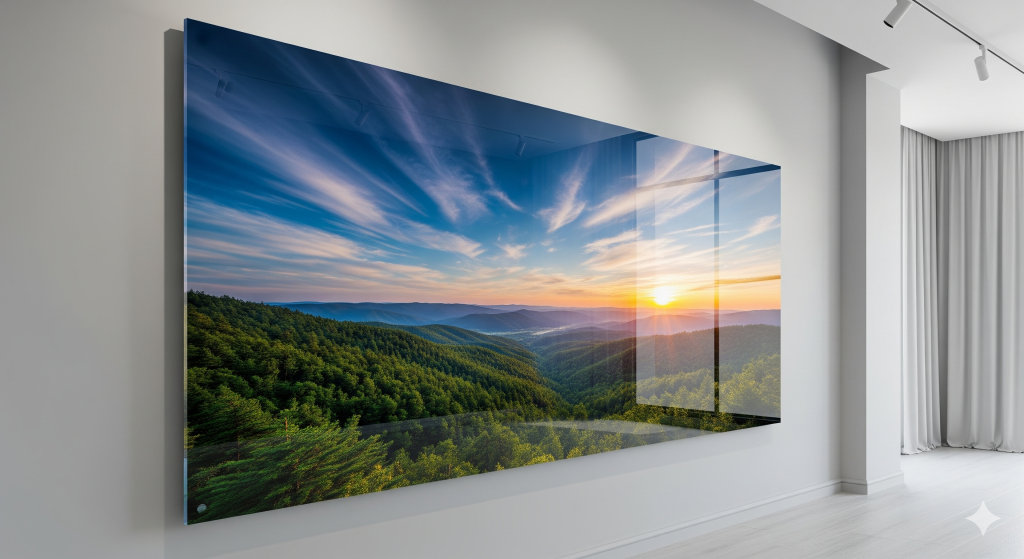
The Verdict: Making the Right Choice for Your Art
The decision between acrylic and glass is ultimately a calculation of value and risk. The evidence overwhelmingly demonstrates that for any photograph or artwork that holds sentimental or monetary value, acrylic is the superior choice. Its combination of optical brilliance, archival protection, and unparalleled safety makes it the modern standard for preservation and display.
Choose Acrylic if:
- You are framing a large piece (anything over 24×36 inches is much safer with acrylic).25
- The framed piece will be shipped or moved frequently.25
- It will be hung in a home with children or pets, a public space, or a high-traffic area.21
- The item being framed is valuable, irreplaceable, or sentimental (e.g., original art, family heirlooms, important documents).20
- You want the most vibrant and true-to-life color presentation possible.7
- Long-term preservation from fading is a primary concern.27
Consider Glass only if:
- Your budget is the absolute primary constraint.
- The item being framed is small, inexpensive, and easily replaceable.
- The frame will be placed in a very secure, low-traffic location where the risk of impact is virtually zero.22
Ultimately, choosing glass for a valuable piece is an unnecessary risk. The primary drawbacks of acrylic—its susceptibility to scratching and static—have been largely mitigated by modern coatings and proper cleaning techniques. The benefits of acrylic, however—its safety, light weight, and superior protective qualities—are inherent and overwhelming. It is the logical, responsible, and brilliant choice for safeguarding your memories.

Part 3: A Frame for Every Story: A Taxonomy of Acrylic Frame Styles
The versatility of acrylic as a material has led to an explosion of frame designs, each tailored to a specific aesthetic and function. Understanding this landscape allows you to move beyond a simple purchase and select a frame that perfectly complements both your image and its intended environment. From minimalist wall displays to elegant tabletop pieces and specialized functional frames, there is an acrylic solution for every story.
Wall-Mounted Frames: Modern Statements for Your Home & Office
Wall-mounted frames are designed to make an impact, transforming a simple photograph into a piece of decor. The clarity and structural properties of acrylic lend themselves to clean, contemporary designs.
- Floating Frames: This popular style creates the striking illusion that your photograph is floating effortlessly on the wall. Typically constructed from one or two clear acrylic panels, the image is sandwiched between them or mounted to a single back panel, leaving a transparent border.30 The effect is minimalist and modern, drawing the viewer’s eye directly to the image without the distraction of a traditional border.32
- Standoff-Mounted Frames: For a professional, gallery-quality presentation, standoff mounting is the premier choice. This method uses cylindrical metal hardware—known as standoffs or studs—to mount the acrylic panel a short distance away from the wall.33 This separation creates a subtle shadow and adds a sense of depth and importance to the display. The standoffs themselves, often made of materials like stainless steel or nickel-plated metal, become a deliberate part of the aesthetic.34 Companies like PrintPosters.in utilize sturdy stainless steel studs for larger frames (12×18 inches and above) to ensure both stability and a sleek, modern finish.2
- Poster & Sign Holders: In commercial settings like retail stores, cinemas, or offices, the ability to change graphics quickly is key. Acrylic poster and sign holders are designed for this purpose. They often feature simple designs where the print can be inserted from the top or side, allowing for easy updates without dismounting the frame.30
- Magnetic Wall Frames: A clean and versatile option, these systems use powerful magnets to secure the frame to the wall. One set of magnets is attached to the wall, and another to the back of the acrylic frame. This eliminates the need for visible hardware like standoffs, creating an exceptionally clean, minimalist look. It also makes repositioning or swapping out entire framed pieces incredibly simple.33

Tabletop & Freestanding Frames: Elegance on Any Surface
For desks, shelves, mantels, and side tables, tabletop acrylic frames offer a modern and stylish way to display memories up close.
- Acrylic Block Frames: These are among the most popular and premium tabletop options. They consist of two thick, solid blocks of crystal-clear acrylic that are held together by small, powerful magnets embedded in the corners.30 The photograph is sandwiched between the blocks. Their substantial thickness allows them to be freestanding without any additional support, and because they are clear on both sides, they can be used for double-sided displays.36 The polished edges of the block catch the light, giving the display a jewel-like quality.
- Bent / Slant-Back Frames: This is the most common and affordable style of tabletop acrylic frame. It is crafted from a single sheet of acrylic that is heated and bent at the bottom to create an integrated, self-supporting base.34 The photo simply slides into the frame from the side or top. Their simplicity and low cost make them ideal for displaying casual photos, menus in restaurants, or promotional flyers in a retail setting.30
- Frames with Stands: Some acrylic frames are designed as flat panels that rely on a separate or integrated stand for support. These stands are often made of metal and may screw into the back of the frame, providing excellent stability.38 This design allows for versatility in orientation, easily accommodating both portrait and landscape photos.40
Specialized Frames for Unique Applications
The unique properties of acrylic allow for its use in specialized contexts where traditional frames would be impractical.
- For the Car: To add a personal touch to a vehicle’s interior, small acrylic frames are available. These are typically designed to clip securely onto a sun visor or come with an adhesive base to stand on the dashboard.42 They often use magnetic closures, making it easy to swap photos. Their acrylic construction ensures they are shatterproof and safe in a high-vibration environment.44
- For the Pooja Room: In a sacred space like a pooja room, the display of deities requires reverence and clarity. While many commercially available religious frames pair acrylic glazing with traditional wood or metal borders 45, a pure, frameless acrylic design offers a modern and exceptionally clear way to showcase these important images. The optical purity of high-quality acrylic ensures the depiction of the deity is vibrant and unobstructed, befitting its spiritual significance.45
- With LED Lights: To make a photo truly stand out, especially in a dimly lit room or for a high-impact commercial display, LED-illuminated frames are an excellent choice. These frames integrate LED strips along the edges (edge-lit) or behind the image (backlit).35 The light is diffused evenly through the acrylic panel, making the photograph glow with a vibrant, eye-catching luminescence. These frames are typically powered via a USB cable or a wall adapter and may come with features like remote controls or the ability to change colors (RGB).35
The form of an acrylic frame is intrinsically linked to its function. A gallery frame uses standoffs to command attention, while a tabletop block frame uses its own mass for stability. By understanding these design categories based on application, you can easily navigate the market and select a frame that is perfectly suited to your specific needs.
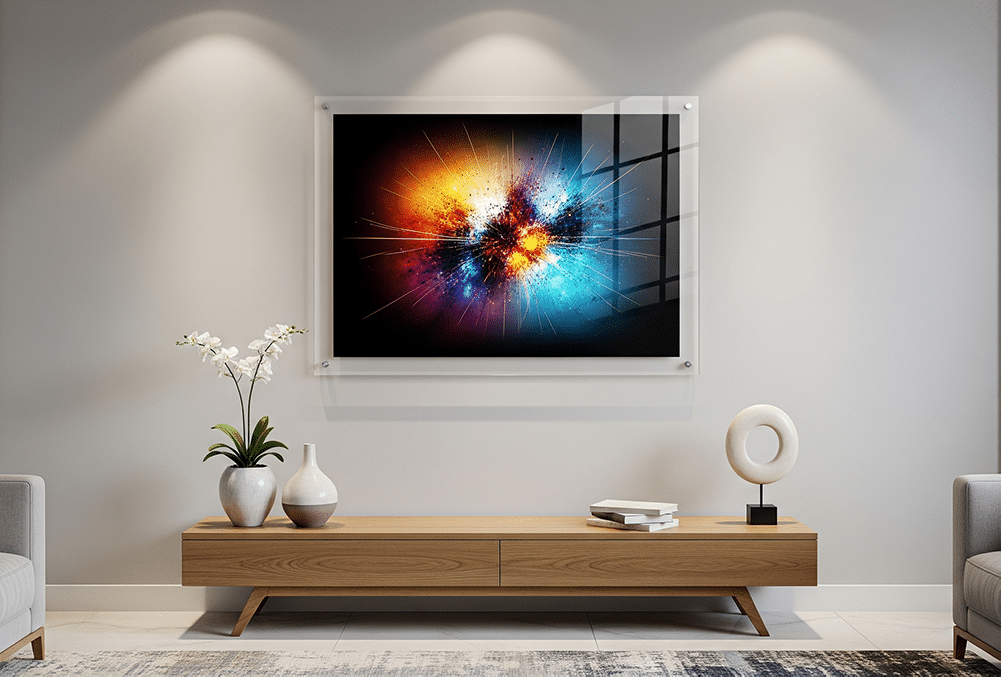
Part 4: The Art of Preservation: Ensuring Your Memories Last a Lifetime
A frame’s purpose extends far beyond mere display; its most critical role is preservation. A beautiful frame that allows the photo within to fade, yellow, or degrade has failed in its primary duty. This is where high-quality acrylic truly distinguishes itself, offering archival properties that meet the rigorous standards of museums and conservationists. Understanding these properties provides peace of mind that your investment will protect your memories for decades to come.
Beyond Clear—Archival Qualities of Acrylic
The term “archival” refers to materials that are chemically stable and will not cause damage to an object over a long period. Museum-grade acrylic is the gold standard for archival glazing for several key reasons.
- Superior UV Protection: As previously discussed, ultraviolet radiation is the invisible enemy of photographs, causing colors to fade and paper to become brittle.26 Conservation-grade acrylic, such as the widely used OP3 formulation, is specifically engineered to block up to 99% of these damaging UV rays.15 This is a significant level of protection. The difference between 99% and 95% UV blocking might seem small, but it is not. A 95% filter allows 5% of UV radiation to pass through, while a 99% filter allows only 1%. This means the 99% UV-protective acrylic is five times more effective at stopping harmful radiation from reaching your artwork, offering a substantially higher degree of preservation.52
- Chemical Stability and Off-Gassing: Paper-based materials, including some low-quality mat boards and wood frame backings, contain an acidic compound called lignin. As lignin ages, it breaks down and releases acid, which can migrate to your photograph and cause it to turn yellow and become brittle.26 High-quality acrylic is chemically inert and stable. It contains no acids and does not “off-gas”—release harmful volatile chemicals over time—that could damage the delicate emulsion of a photograph.15 This is a critical advantage, as the enclosed environment of a picture frame can trap such chemicals, accelerating deterioration. While PMMA itself is highly stable, specialized additives can be incorporated during manufacturing to further enhance its photo-stability and inhibit any potential for degradation.53
- Moisture Resistance: The question of whether acrylic frames are “waterproof” is common. The acrylic material itself, PMMA, is non-porous and waterproof.1 It will not absorb moisture or allow water to pass through it. Therefore, a well-constructed acrylic frame is highly water-resistant. It provides excellent protection against ambient humidity, making it suitable for display in environments like bathrooms or kitchens where moisture levels are high.56 However, it is important to note that the entire frame assembly is not designed to be submerged or exposed to a direct, prolonged stream of water, as moisture could potentially seep in through the edges between panels.57 For all practical purposes of protecting a photo from airborne humidity and splashes, acrylic offers robust and reliable defense.
The Myth of Yellowing: Will My Acrylic Frame Discolor?
One of the most persistent concerns about using acrylic is the fear that it will yellow over time, a characteristic associated with older, lower-quality plastics. This concern is a myth when it comes to modern, high-quality PMMA.
The yellowing of plastics is primarily caused by degradation from UV radiation. However, high-grade acrylic manufactured today, particularly in the United States and Europe, has UV stabilizers integrated directly into its chemical structure during the polymerization process.10 This makes the material inherently resistant to yellowing when exposed to sunlight.9
The historical evidence is compelling. As mentioned, acrylic canopies from World War II aircraft, after decades of exposure to intense, high-altitude UV radiation, remain optically clear.9 In contrast, it is not uncommon for older, lower-quality glass to develop a yellow or hazy tint over time due to impurities in the material.9 While it is true that any polymer will eventually degrade after extreme, prolonged exposure, a well-cared-for acrylic frame can be expected to maintain its clarity for well over a decade, with many lasting 15 years or more without any noticeable discoloration.59
The fear of yellowing is a relic of outdated material science. Modern, UV-stabilized acrylic offers superior long-term color stability and clarity. By choosing a reputable supplier that uses high-grade, non-yellowing acrylic, you are investing in a material designed from its molecular core to provide a lifetime of crystal-clear protection for your memories.

Part 5: Your Definitive Guide to Buying Acrylic Frames
With a deep understanding of what makes a quality acrylic frame, the next step is to find the right one for your needs. India offers a diverse market, from accessible retail shops for standard sizes to specialized manufacturers for custom and bulk orders. This guide provides a curated look at the city’s resources, helping you navigate the options and connect with the right supplier, whether you’re buying a single frame for your desk or outfitting an entire office.
For Everyday Needs: Retail Shops in India
For those seeking standard-sized frames for common photo prints, several retail stores across India offer ready-made acrylic options. These are convenient for quick purchases and general-purpose framing. Look for Printposters.in which offers all best varieties in Acrylic
For the Professional & Discerning Buyer: Manufacturers and Wholesalers
For professionals, artists, interior designers, or anyone requiring custom sizes, superior quality (cast acrylic), or bulk quantities, going directly to a manufacturer or specialized supplier is the best approach. India is home to a robust ecosystem of such businesses.
The Best of Both Worlds: Custom Online Printing Services
For many, the ideal solution lies with online services that combine the quality and customization of a manufacturer with the convenience of online ordering and direct delivery to any city in India. These platforms are perfect for turning your digital photos directly into finished, framed pieces.
- PrintPosters.in : As a specialized provider of high-quality prints, PrintPosters.in offers a premium acrylic framing service that stands out on several key metrics. This is where the knowledge gained from this guide can be directly applied to appreciate a superior product offering:
- Premium Material: They use 5 mm thick clear acrylic glass, providing a substantial feel and excellent durability.2
- Advanced Printing Technology: Utilizing a sophisticated 10-color or 12-color printing process ensures exceptional color vibrancy, detail, and an impressive 98% accuracy in reproducing Pantone shades.1
- Professional Hardware: For larger frames (12×18 inches and up), they include high-grade stainless steel studs for secure and stylish wall mounting, a feature typically found in gallery installations.2
- Extensive Customization: They offer an unparalleled range of custom sizes, from a compact 8×8 inches to a massive 48×96 inches (4 by 8 feet), catering to virtually any custom art project.2
- Quality Guarantees: Their frames are waterproof, UV-resistant, and come with a “BEST PRICE GUARANTEE,” positioning them as a provider of high-end, value-driven solutions delivered directly to your doorstep across India.1

Part 6: The Practical Owner’s Manual: Installation, Cleaning, and Care
Owning a beautiful acrylic frame is only the beginning. Proper installation, cleaning, and care are essential to ensure it looks its best and protects your memories for years to come. This section provides practical, step-by-step instructions for the complete ownership experience.
How to Install Your Wall-Mounted Acrylic Frame
While various methods exist, standoff mounting is the most common for the high-quality, frameless acrylic prints offered by premium suppliers. It provides a secure, professional, and visually stunning “floating” effect.
Standoff Installation: A Step-by-Step Guide
- Gather Your Tools: Before you begin, assemble the necessary tools. You will need a bubble level, a tape measure, a pencil, a drill or screwdriver, and potentially wall anchors if you are mounting on drywall.69 The standoff hardware itself (barrels, caps, and screws) should be included with your frame.
- Position and Mark the Wall: This is the most critical step for a level installation. Hold the acrylic print against the wall in the exact desired location. Place the bubble level on top of the print and adjust until it is perfectly horizontal. Once level, ask a helper to hold it steady while you use a pencil to mark the wall through each of the pre-drilled holes in the corners of the acrylic.70
- Drill and Install Anchors (if needed): If your wall is drywall, it is highly recommended to use wall anchors for a secure hold. Drill a hole at each of your pencil marks that is appropriately sized for your anchors. Gently tap the anchors into the holes until they are flush with the wall.
- Mount the Standoff Barrels: A standoff consists of two main parts: the barrel (the hollow cylinder) and the cap (the screw-in front piece). Separate these. Place a screw through the hole in the back of each barrel and drill the barrels securely into the wall at your marked locations (or into the anchors you just installed).70
- Hang the Acrylic Print: With all four barrels securely mounted to the wall, align the holes in your acrylic print over the barrels. Place a protective washer (if provided) over the front of the acrylic at each hole. Finally, screw the standoff caps through the acrylic and into the barrels until they are hand-tight. Do a final check with the bubble level and make any minor adjustments before fully tightening the caps.70
| Wall Mounting Method | Best For | Tools Required | Difficulty | Wall Damage |
| Standoffs | Gallery-quality, modern look for frameless prints of any size. | Drill, level, tape measure, pencil, anchors. | Moderate | Requires 4+ drilled holes. |
| French Cleat | Very large or heavy acrylic frames; provides excellent support. | Drill, level, tape measure, pencil. | Moderate | Requires drilled holes for the wall cleat. |
| Adhesive Strips | Small, lightweight frames; ideal for renters or damage-free hanging. | Level, tape measure. | Easy | None, if removed correctly. |
| Cable System | Gallery walls, displays that require frequent rearrangement. | Drill, level, wire cutters. | Advanced | Requires drilled holes for ceiling/wall tracks. |

How to Clean and Maintain Your Acrylic Frame
Proper cleaning is crucial to maintaining the crystal clarity of your acrylic frame without causing scratches. Using the wrong materials can permanently damage the surface.
The Do’s and Don’ts of Cleaning Acrylic:
- DO use the right cloth. The best tool is a soft, clean, lint-free microfiber cloth. Its fine fibers trap dust effectively without abrading the acrylic surface.28
- DO use the right cleaner. For general dusting, a dry microfiber cloth is sufficient. For smudges or dirt, use either a specialized acrylic cleaner (such as Brillianize or Novus #1) or a simple solution of mild dish soap and lukewarm water.73 These cleaners are gentle and will not harm the acrylic. Many specialized cleaners also have anti-static properties that help repel dust.28
- DO wipe gently. Apply light pressure and wipe in a gentle, circular motion to remove dirt and buff the surface.75
- DO NOT use paper towels or abrasive rags. Paper towels are made of wood pulp and are abrasive enough to cause fine scratches (micro-scratches) on the acrylic surface.28
- DO NOT use harsh chemical cleaners. Strictly avoid any cleaners that contain ammonia (like Windex), alcohol, or other abrasive or aromatic solvents. These chemicals can cause the acrylic to become cloudy, hazy, or even develop fine cracks over time, causing irreversible damage.28
For minor scratches that may occur, specialized polishing compounds like Novus #2 (Fine Scratch Remover) and Novus #3 (Heavy Scratch Remover) can often be used to restore the surface finish.76
How to Open Your Frame and Change the Picture
The method for opening an acrylic frame depends entirely on its design.
- For Magnetic Block Frames: This is the simplest type to open. The two acrylic blocks are held together only by the force of the magnets. Simply grip the two panels and pull them apart. To avoid fingerprints, handle the blocks by their edges. Place your new photo on one panel, align the second panel on top, and the magnets will snap them securely back together.77
- For Frames with Flexible Tabs or Rotating Clips: These are common on frames with a traditional backing board. Place the frame face down on a soft cloth to protect the front surface. Use your fingers or a flathead screwdriver to gently bend the flexible metal tabs upward or to rotate the plastic clips so they no longer hold the backing board in place. Once all tabs/clips are released, the backing board and its contents can be lifted out.78
- For Standoff or Screw-Together Frames: These frames are held together by the hardware itself. To change the picture, you must first unscrew the four standoff caps or binding screws. This will allow you to separate the two acrylic panels, change the graphic, and then reassemble the frame.34

Conclusion
The journey from a fleeting digital file to a lasting physical artifact is completed by the choice of its frame. This guide has demonstrated that the acrylic photo frame is not merely an alternative to glass but a comprehensive upgrade in nearly every aspect that matters: safety, durability, optical brilliance, and archival preservation. The science behind Poly(methyl methacrylate) reveals a material engineered for performance, with a legacy of trust built in the most demanding applications. When compared directly to glass, acrylic’s advantages—its shatterproof nature, light weight, and superior UV protection—make it the clear and responsible choice for protecting anything of value.
Understanding the nuances of the material, such as the critical quality difference between cast and extruded acrylic, empowers the consumer to make an informed investment. The diverse world of acrylic frames, from elegant wall-mounted displays to modern tabletop blocks, offers a perfect solution for every image and every space. Furthermore, the knowledge that high-quality, modern acrylic is chemically stable and will not yellow over time provides the confidence that this investment is a lasting one. For residents of India, the local market offers a rich tapestry of options, from convenient retail stores to specialized manufacturers and world-class online services that deliver custom, gallery-quality products to your door.
Ultimately, an acrylic frame is more than a piece of plastic; it is an investment in the clarity and longevity of your most cherished memories. It ensures that the moments you choose to make permanent are displayed with the vibrancy they deserve and are shielded by the best protection modern material science can offer. As you look to bring your own photos to life, consider the unparalleled quality, durability, and brilliance that a premium acrylic frame provides. Explore the custom options available at PrintPosters.in, and give your memories the timeless, elegant, and secure showcase they have earned.












